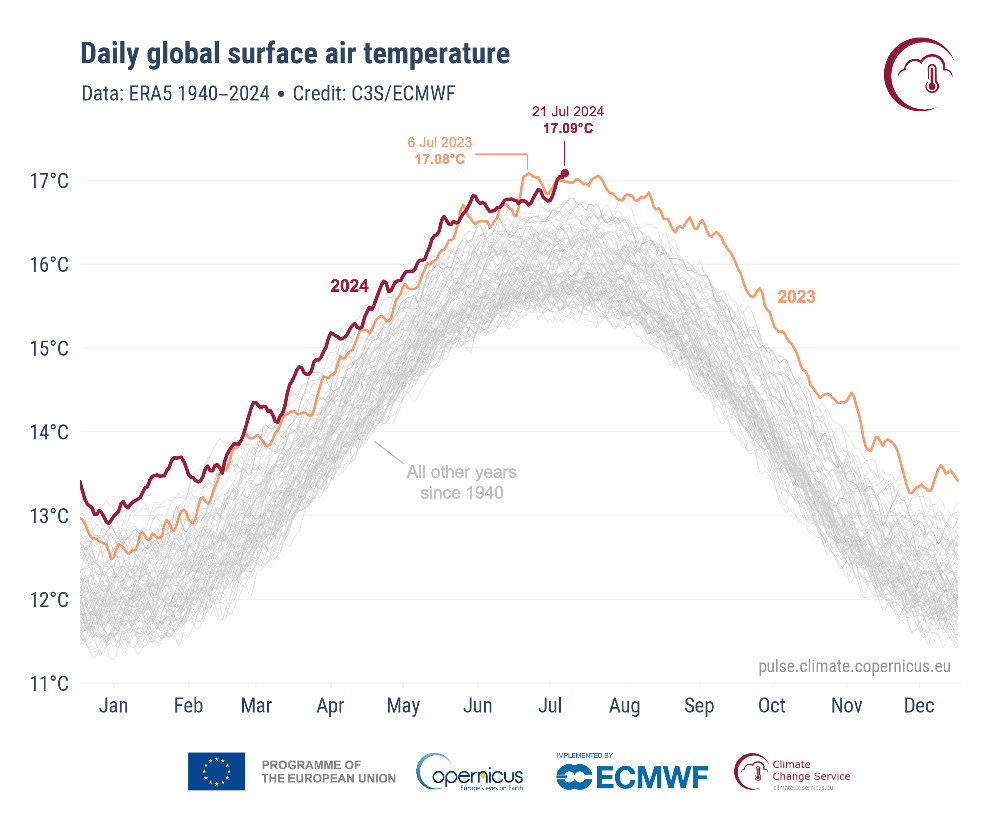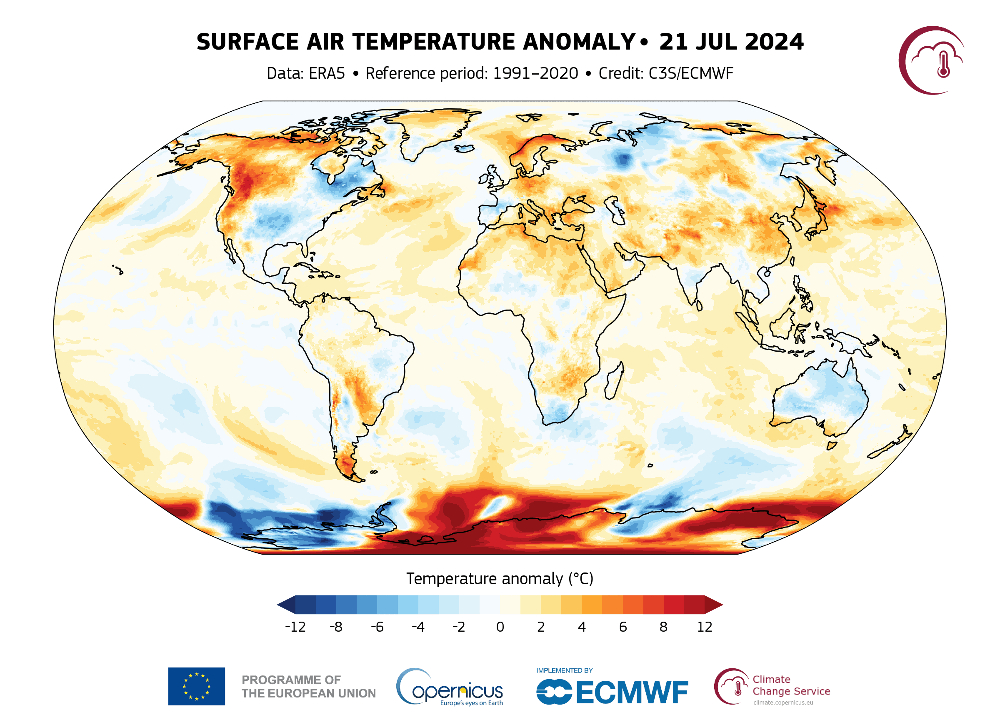Sign up for daily news updates from CleanTechnica on email. Or follow us on Google News!
According to the Copernicus Climate Change Service, Sunday, July 21, 2024 was the hottest day on Earth since at least 1940, with the average temperature being 17.09°C. The new record is only a tiny bit hotter than the previous record — 0.01°C hotter to be precise — but what really stands out is the difference between the temperatures since July 2023 and all previous years. The data can be explored in Climate Pulse, the C3S application that provides historical and near real-time temperature data from the ERA5 reanalysis dataset. Before July 2023, the previous daily global average temperature record was 16.8°C, set on August 13, 2016. Since July 3, 2023, there have been 57 days that have exceeded that previous record, distributed between July and August 2023 and then during June and July so far in 2024.

According to C3S Director Carlo Buontempo: “On July 21st, C3S recorded a new record for the daily global mean temperature. What is truly staggering is how large the difference is between the temperature of the last 13 months and the previous temperature records. We are now in truly uncharted territory and as the climate keeps warming, we are bound to see new records being broken in future months and years.”
Analysis of the years with the highest annual maximum daily global temperatures shows that both 2023 and 2024 have seen annual highs substantially above those recorded in previous years. Another sign of the global heating trend is the fact that the ten years with the highest daily average temperatures are the last ten years, from 2015 to 2024.
Our analysis suggests that the sudden rise in daily global average temperature is related to much above-average temperatures over large parts of Antarctica, Copernicus says. Such large anomalies are not unusual during the Antarctic winter months, and also contributed to the record global temperatures in early July 2023. What’s more, Antarctic sea ice extent is almost as low as it was at this time last year, leading to much above-average temperatures over parts of the Southern Ocean.

Now, admittedly, the news from Copernicus only relates back to 1940, the first year such temperature information was recorded. So, all you climate deniers out there, put away your poison pens and forget about sending us nasty notes about how the Earth was hotter when dinosaurs roamed the Earth. We freely admit that is so. The point here is that on Sunday, July 21, 2024, Earth’s average surface temperature was hotter than at any time we have data for. We are sorry if that does not agree with whatever spiritual, religious, or political beliefs you may personally, hold but reading a thermometer is not a metaphysical exercise. Deal with it.
New Meltwater Current Discovered In Antarctica
There is other news that is a harbinger of dangerous times ahead for our little blue orb at the far fringe of a minor galaxy. Researchers at Caltech last month published the results of their latest study of ocean currents in and around Antarctica. In the summary to their research, they say: “Floating ice shelves in West Antarctica are thinning, which is largely due to melting of the ice shelf base by the ocean. Here, measurements of ocean temperature, salinity, and dissolved oxygen, collected by a remotely-controlled underwater vehicle (a glider), are used to estimate the amount of ice shelf meltwater released in the Bellingshausen Sea. Distinct cores of meltwater can be distinguished by the amount of suspended material that is present in the water, which we attribute to meltwater following different circulation pathways after entering the ocean.
“Historical data from seals equipped with temperature and salinity sensors provide additional information about how the meltwater circulates in the region. The seal data show the presence of a narrow coastal current that brings meltwater from the Bellingshausen Sea into the Amundsen Sea. The pathways of meltwater revealed in this study suggest an important influence of the Bellingshausen Sea on ice shelves throughout West Antarctica.”
In addition to underwater drones, the researchers gathered data from sensors glued to the heads of seals. Lest you think doing so is animal cruelty, be assured that the seals molt every few months, and when they do, the sensors are shed along with their pelts.
This latest research shows that Antarctic ice shelves are melting at an accelerated rate. Most of the melting comes from below the ice shelves, the result of warm water flowing underneath them. As the meltwater enters the ocean, it is carried around the coast of Antarctica by ocean currents, modifying melt rates at ice shelves farther downstream. “We used to think about ice shelves as isolated systems, but we now understand that multiple ice shelves are connected by currents along the Antarctic coast,” says Andy Thompson, a professor of environmental science and engineering at Caltech. “What happens in one ice shelf changes the processes at another. To accurately predict changes, we have to understand the domino effect they have on one another.”
In this latest research, the team discovered a new current that meltwater follows through a region known as the Bellingshausen Sea, on the side of Antarctica nearest to South America. “The Bellingshausen Sea is not a well-studied region, but it’s the first place where warm water from the Atlantic and Pacific oceans reaches the ice shelves,” says Thompson. “As it melts the ice shelves, the water becomes cooler and fresher, decreasing its capacity to melt.”
The team identified two distinct meltwater pathways that originate from different ice shelves. One follows the coast and can increase melting at downstream ice shelves by trapping warm waters at depth, while the other path returns to the open ocean. The data collected from the sensors attached to the seals revealed a previously unknown trough, or canyon, in the seafloor, which the team dubbed Seal Trough. Underwater topographic features like Seal Trough influence the flow of currents similarly to how canyons on dry land guide the flow of rivers.
Where Does That Warmer Water Come From?
Gosh, what is the source of that warmer water? Could it be human activity? Hmmm, researchers at the University of New South Wales estimate over a period of 50 years, humans — that would be you and me and several billion of our relatives — have added the heat of more than 25 billion atomic bombs to the environment. Some of that heat has warmed the atmosphere, but most of it has been absorbed by the oceans. The price of a lobster roll in Maine is now $35 or more. Why? Because the waters off the coast of that state have warmed to the point where the lobsters have left their ancestral homes in search of colder water further north. Astute readers will make a connection between those lobsters and the waves of human climate refugees moving away from their own ancestral homes to seek cooler climes.
The Daily Kos began its story about the Caltech research with a quote from Jeff Goodell. a writer and journalist whose latest book is entitled The Heat Will Kill You First: Life and Death on a Scorched Planet. “The first … consequence of the human race’s trip out of the Goldilocks Zone will be the widening of the thermal divide, the invisible but very real line that separates the cool from the suffering, the lucky from the damned,” he said.
And how are humans responding to the evidence that the world is getting hotter? By extracting and burning more of the fossil fuels that are the primary cause of global heating. Does that make any sense? Of course not, but we are so dependent on fossil fuels, we cannot find a way to break that dependency without a drastic rearrangement of our priorities. Here’s a recent example of how human society is going backwards despite an abundance of evidence that we are digging our own graves.
Elon Musk was once a champion of the “Electrify Everything!” school of thought. In March of 2023, while laying out his Master Plan Part III, he said, “The thing that we wanted to convey, probably more importantly than anything else that we’re talking about here, is that there is a clear path to a sustainable energy Earth. There is a clear path to a fully sustainable Earth with abundance.” This week, Bloomberg reports, he has changed his tune. Writing on X, he said, “Civilization does need oil & gas for quite some time. I don’t think we should demonize an industry that is essential for humanity to function.”
Make of that what you will, but it is a far cry from the push to end fossil fuels most thoughtful people know will be essential to maintaining the Earth as a place where human civilization can thrive. Musk, with his incalculable wealth, has placed himself in Jeff Goodell’s lucky group, but by backtracking on his vision of a sustainable planet, he has consigned most of the rest of us to the category of the damned.
Have a tip for CleanTechnica? Want to advertise? Want to suggest a guest for our CleanTech Talk podcast? Contact us here.
Latest CleanTechnica.TV Videos
CleanTechnica uses affiliate links. See our policy here.
CleanTechnica’s Comment Policy




